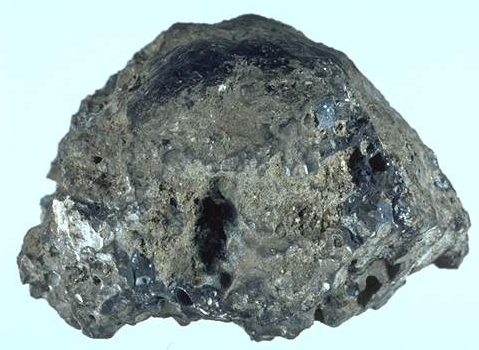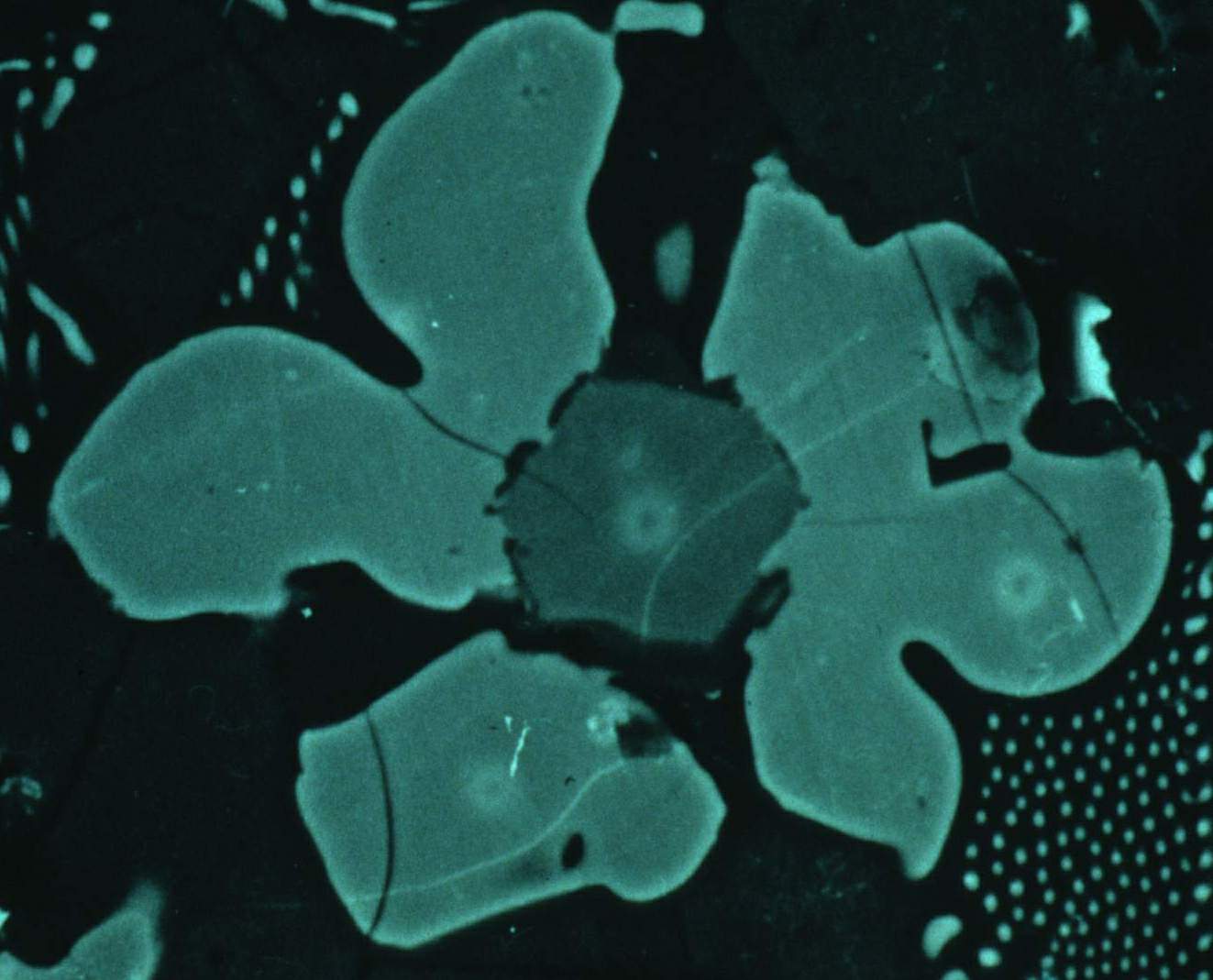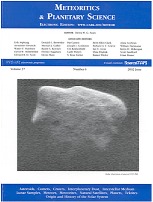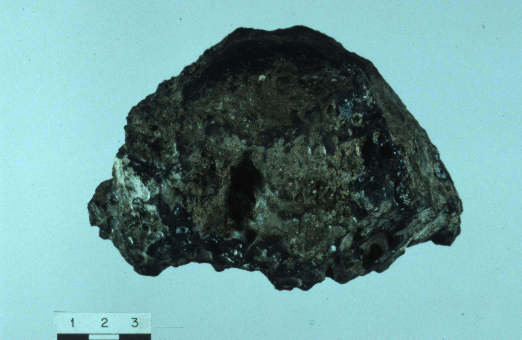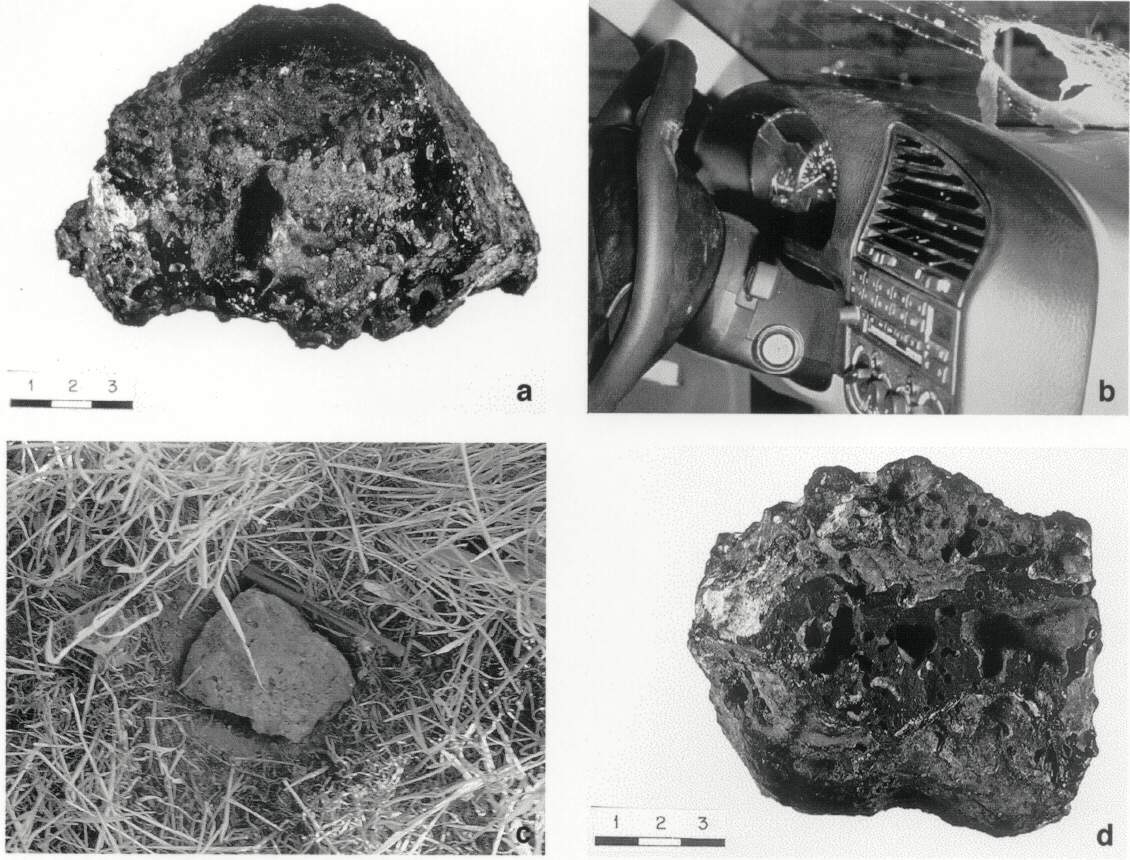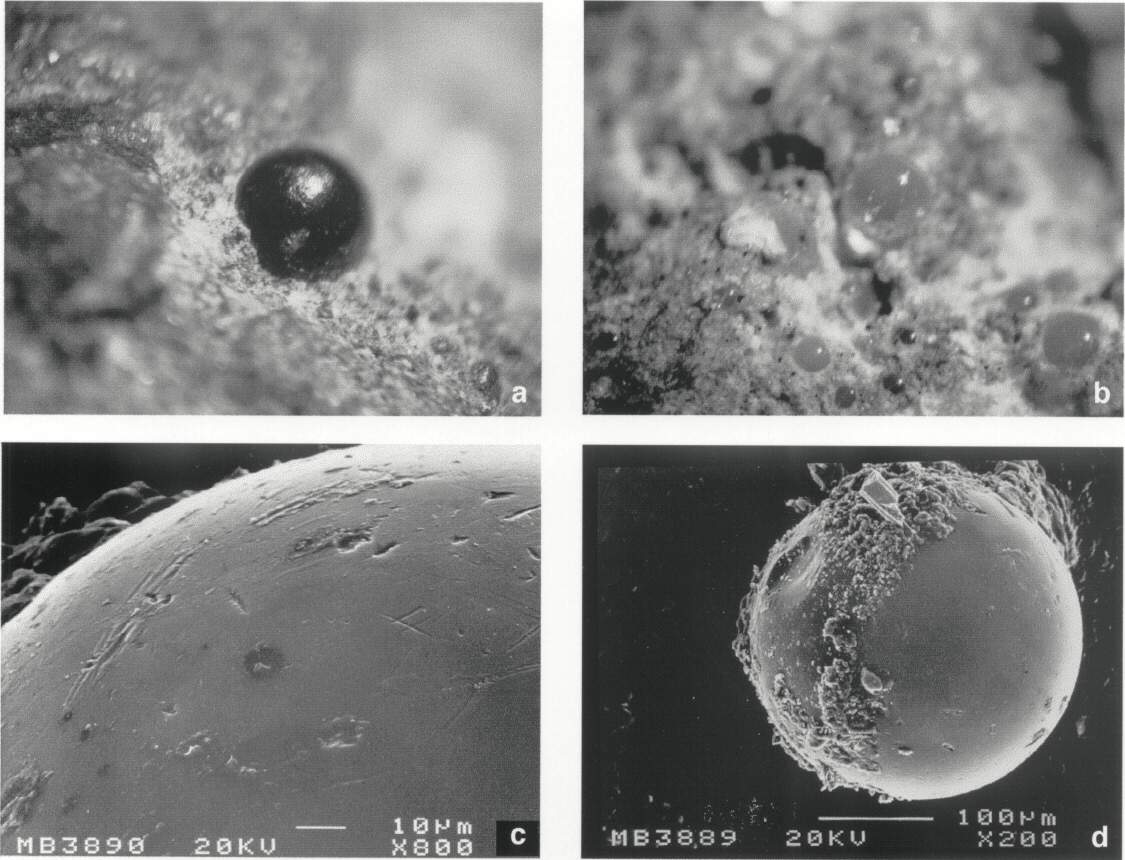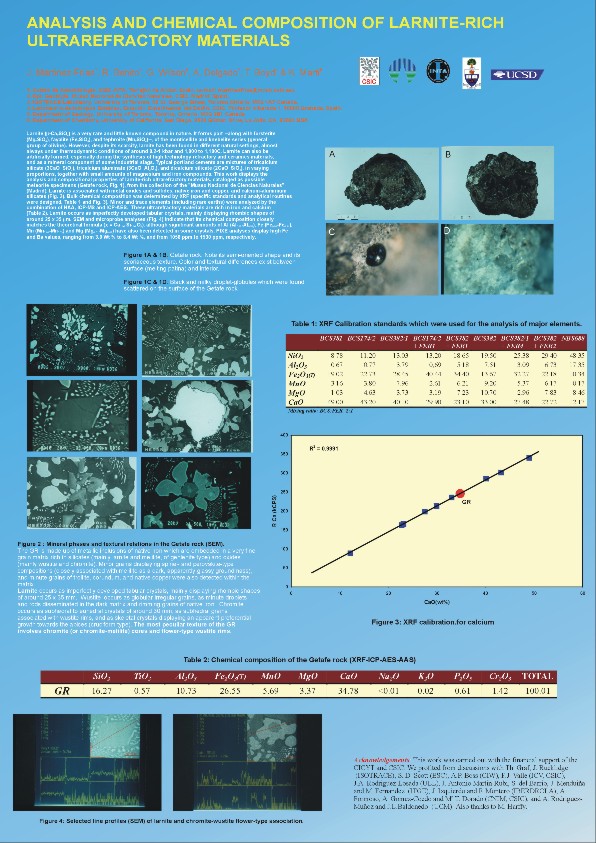|
PARAGENESIS AND MINERAL CHEMISTRY
Minerals were identified by XRD, transmitted and reflected light
microscopy, SEM, and electron microprobe. The GR is made up of a fine grained
matrix rich in silicates (mainly larnite and melilite, of gehlenite type)
and oxides (mainly wustite and chromite) and inclusions of native iron
metal. Minor grains displaying spinel and perovskite compositions (closely
associated with melilite as a dark, apparently glassy ground mass), and
minute grains of troilite, corundum, and native copper were also detected
within the matrix.
Although it is difficult to establish a clear crystallization
sequence, ore textures seem to reflect a combination of several processes
which include: rapid cooling and rapid growth (quenching) from a liquid
(as indicated by the presence of acicular, dendritic and spherulitic
textures), varying proportions of melted and crystallized zones and some
recrystallization. Apart from the individual textural characteristics of
the different mineral phases which will be described below, the most peculiar
texture of the GR involves chromite (or chromite-melilite) cores and flower-type
wustite rims.
Specific PIXE probe analyses were also carried out on
18 spots (6 on iron, 2 metal?oxide (wustite) blebs, 7 melilites and
3 larnites). The PIXE data show that PGE and the rare earth elements
(REE), are below detection limits (detection limits for Re, Os, Ir,
Pt and Au are 20?40 ppm, and for La are 30 ppm in larnite, 80 ppm
in melilite). From Martinez-Frias et
al (1999)
GEOCHEMICAL (AND ISOTOPIC) CHARACTERISTICS
Major, minor and trace elements (including REE) of the
GR were determined by NAA, ICP-MS, ICP-AES, XRF and AAS. The bulk
geochemical composition is rich in iron and calcium (Fe=18,57% and Ca=24,86%),
(reflecting the mineral phases given above), Si (7,60%), Al (5,68%), Mn
(4,41%), Mg (2,03%), Cr (0,97%) and Ti (0,34%). The refractory trace elements
Zr, Nb, Sr and Ba are extremely high (20 x CI - 800 x CI) and Y, Ti and
V are £ 10 x CI; Sc is low (0,2 x CI), and the light REE (La,Ce)
are 40 x CI, while the heavy REE are less enriched (approx. 10 x CI). The
Ni content is 18 ppm. Its chondrite-normalized REE distribution pattern
indicates strong fractionation from LREE to HREE. The oxygen data
plot on the terrestrial fractionation line. d 8O values of +16.3% and +15.6%,
and d 17O values of 8.1% and 8.0% (rel. To SMOW), which are rather high.
From
Martinez-Frias et al (1999).
COSMIC RAY RECORDS
Cosmic-ray produced nuclides
are excellent tracers for the exposure of rocks in space. As the cosmic
ray flux at the location (~40° geomagnetic latitude, ~650 m above sea
level) of Getafe is about three orders of magnitude lower than in interplanetary
space, cosmic ray produced nuclides are expected to answer the question
whether space exposure did occur. A pilot study showed essentially terrestrial
atmospheric composition for the light noble gases with slight excesses
of 21Ne and 40Ar. Therefore, a detailed study of a 388 mg sample of bulk
material for all noble gas isotopic abundances was conducted using techniques
developed for the study of surface exposure times of terrestrial rocks.
Noble gases were released by stepwise heating the sample in a resistance-heated
tantalum crucible. The evolved gases were cleaned on a titanium sponge
getter and a SAES NP-10 and separated cryogenically. Xenon, krypton, and
argon were adsorbed on a stainless steel frit at 77K and neon and helium
were adsorbed on charcoal at 35K and 11K, respectively. All gases were
analysed sequentially by static mass spectrometry using Daly and Faraday
detectors on a customized VG5400. Air standards were used for calibration
of sensitivities and mass discrimination. An aluminum foil was analyzed
for background correction using the same procedures as for the sample.
Krypton and xenon are consistent with atmospheric abundances
and are not given. Neon isotopic ratios of all temperature steps are (within
2.3s) equivalent to air except for the 22Ne/20Ne in the 1,100°C fraction
that is higher. The slight 21Ne-excess, (2.12±0.81)·106atoms/g,
can be used to obtain only an upper limit for the space exposure time of
the rock, since some excess may also be due to the 18O(a,n)21Ne reaction.
With this assumption and using average 21Ne-production rates for space
exposure, P21 = 30,000 atoms/gram/year, we calculate a space exposure age
of <97 years. Alternatively, if we consider only a terrestrial history,
and adopting the cosmic ray production rate of 21Ne in terrestrial silicon,
P21 = 45 atoms/gram Si/year, corrected for latitude and altitude, P21 =
74 atoms/gram Si/year, and the silicon abundance (7.6%), we obtain a terrestrial
surface exposure age of <520,000 years. Using modeled terrestrial surface
exposure 21Ne-production rates taking into account contributions from Na,
Mg, Al, Si, Ca, Fe, we obtain P21 = 19 atoms/gram/year, and derive an age
of <149’000 years. All these ages are upper limits because a small 22Ne
excess (1,100°C fraction) suggests either a nucleogenic contribution
from the 19F(a,n)22Ne reaction or a trapped Ne signature distinct from
atmospheric Ne.
The argon concentration (36Ar = 8.65·10-9cm3STP/g)
and isotope ratios, which barely exceed the atmospheric value, imply a
limit of radiogenic 40Ar < 2.34·10-8cm3STP/g, which coupled to
the measured potassium abundance (166 ppm) yields a maximum gas retention
age of 27.6·106 years. Minor variations are also observed in the
38Ar/36Ar ratios and indicate a nucleogenic component or fractionation
effects.
The 14C activity (T1/2 = 5730 a) was determined in a bulk
powder sample and also in the acid soluble phase and in the residue of
the treated sample. The bulk sample has a C concentration of 0.38% (by
weight) and a 14C activity of (1.037±0.009) times modern terrestrial
C, or 51.6±0.5 dpm/kg. The acid-soluble phase revealed a fraction
of (1.079±0.006) and the residue one of (0.870±0.008) times
modern terrestrial. If interpreted as an activity induced by cosmic rays
in space, this would correspond to a close to saturation activity. However,
the activities observed in different phases (acid soluble vs. acid insoluble)
are very different and do not agree with typical activities induced in
space.
To check the possibility that cosmic-ray produced Ne could
have been lost from the rock, 10Be in the bulk rock was also measured;
the activity was extremely low with an upper limit of 0.01 dpm/kg. Therefore,
both nuclides, stable 21Ne and radioactive 10Be allow upper limits for
the space exposure time of 103 years. A possible interpretation could be
that the carbon is terrestrial material. Carbon with a “fraction of modern”
of 1.03 to 1.08 can only have been formed in the period of 1955-1958 AD
and not earlier or more recently. From
Martinez-Frias et al (1999
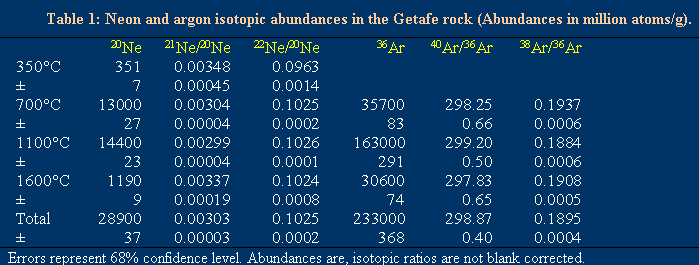
From Martinez-Frias et al (1999)
| In 1994 a moving car and its driver,
on a highway in southern Madrid (Getafe), were struck by a falling rock.
Eighty-one additional fragments (total weight : 55.926 kg) were later recovered,
which all pointed towards a meteorite fall. A study of the composition
of this object revealed an ultrarefractory material displaying a most unusual
chemical make-up which differs from any known meteorite class, and for
some elements and minerals approaches the composition of CAI (Ca-Al-rich
inclusions in chondrites). A study of some cosmic-ray- produced stable
and radioactive nuclides indicates: a) space and terrestrial exposure ages
which do not exceed 1,000 and 520,000 years, respectively; b) the presence
of a small 22Ne excess (1100ºC fraction), which suggests either a
nucleogenic contribution from the 19F(?,n)22Ne reaction or a trapped Ne
signature distinct from atmospheric Ne, and c) the existence of minor variations
in the 38Ar/36Ar ratios also indicating a nucleogenic component or fractionation
effects. 14C data are consistent with “modern” carbon originated in the
period 1955-1958 and not earlier or more recently. The possibility that
Getafe could have a man-made origin (i.e. ceramic and refractory tiles,
industrial slag) is also considered.
"...In short, it is difficult to
conclude, without reasonable doubt, what the real origin of the Getafe
rock is. Could it be an unusual (and unique) CAI-type extraterrestrial
rock, which underwent significant isotopic fractionation, and which, despite
this, still preserves remains of the nucleogenic contribution such as those
reflected by the small 22Ne excess (1100ºC fraction), and
the minor variations of the 38Ar/36Ar ratios?..."
This would support the theory
of CAI accumulation in kilometre-sized bodies (piñatas) with relatively
stable orbits, during the first differentiation stages of the primitive
solar nebula (Boss 1995). In fact, this author points out, citing W.R.
Skinner, that the large CAI-filled piñatas would have to be broken
apart 10 Ma later, releasing the CAIs for incorporation into chondritic
bodies...."
From Martínez-Frías
et al (1999) Revista de Metalurgia 35: 308-315
Acknowledgements : This
research was carried out thanks to the financial backing of the Spanish
CSIC and CICYT. Special thanks to Prof. Alan P. Boss and K. Marti,
the 'Museo Nacional de Ciencias Naturales' de Madrid, J.M. Martin
and Madrid Directo.
|
|
